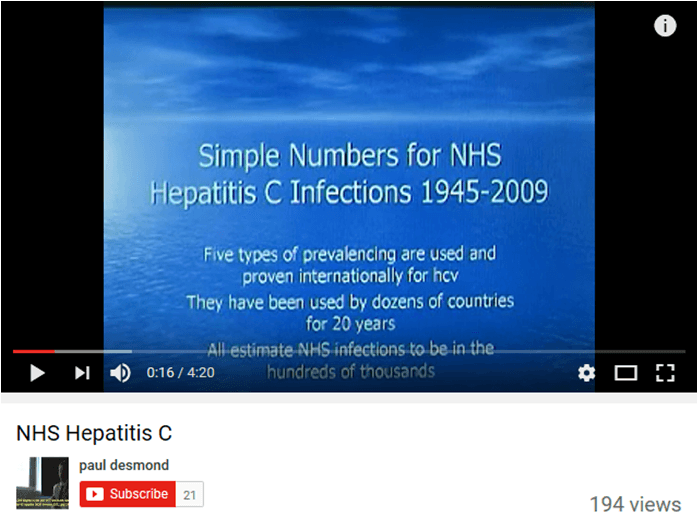Hepatitis C Contaminated NHS Transfusions
A UK epidemic of 250,000 infections from a blood supply at 1 to 2% infectious would be a low estimate, using the already NHS admitted infection rates admitted below. To get this in perspective
America admitted an infection rate of 7 to 10%
The EU 2%
France 4%
Italy, Spain, Brazil 6%
Canada 2%
While all these countries and the World Health Organisation were involved in a race against time to test the patients at risk and launch massive inquiries and prevalencing studies during the period 1992 to 1999. The entire NHS noted 5232 infections in that period, of a known 500,000 plus Hepatitis C infections in the UK. The lowest use of the Hepatitis C test in the developed world.
The World Health Organisation said Death Certify this transfusion hepatitis c epidemic and "look back" warn/test every patient at risk in 1999, and it's nearly twenty years later and neither the UK Government and its Department of Health still don't tell patients to test.
If we knew one in 70 transfusions was from a junkie, if we knew one in 39 NHS transfusions had hepatitis c, as revealed in the only study done and detailed below.
We'd be able to make our own decisions, and not have them made for us, about transfusion hepatitis c and testing.
Instead we got the report below, published but never publicised to a million plus patients whose very lives depend on seeing it. The article clearly states that the actual tests to study the issue found the blood supply was 2.6% Hepatitis C infectious from 1965 to 1985.
Laboratory surveillance of hepatitis C virus infection in England and Wales: 1992 to 1996.
PHLS Communicable Disease Surveillance Centre, Immunisation Division, London. mramsay@phls.co.uk
Screening assay for antibody to hepatitis C virus (HCV) became available late in 1990 and their use has subsequently become widespread. Laboratories in England and Wales reported 5232 confirmed HCV infections to the PHLS Communicable Disease Surveillance Centre (CDSC) between 1992 and 1996.
In 1993, a survey of people tested between 1990 and 1993 revealed that the prevalence of antibody was high among recipients of blood or blood products (189/548 [34%]) and lower among other groups.
In a survey of HCV tests performed in transfusion recipients in early 1995, the prevalence of antibody was higher in those transfused before 1985(11/418 [2.6%]) than in those transfused after 1985 (14/1441 [1.0%]).
PMID: 9644120 [PubMed - indexed for MEDLINE]
The next published by our NHS article below states that at the end of using UK prisons for blood donation in 1985 the populations of England and Wales were testing 1% plus Hepatitis C positive. A 1.07% figure means 600,000 people had hepatitis c in 1986 and a 0.93% figure means 550,000 people had hepatitis c in 1996. Yet we have been and still are being told only 220,000 people are infected? The bulk of the extra infections is 300,000 healthcare infections from here and overseas.
The prevalence of hepatitis C in England and Wales.
Immunisation Division, PHLS Communicable Disease Surveillance Centre, Balogun MA, Ramsay ME, Hesketh LM, Andrews N, Osborne KP, Gay NJ, Morgan-Capner P
OBJECTIVES: To estimate the background population prevalence of hepatitis C in England and <country-region><place>Wales, observe the prevalence over time and assess the extent of infection outside of known risk groups.
METHODS: Sera from residual specimens from adult patients submitted to laboratories in England and Wales were tested for anti-HCV. Testing was carried out using a cost-effective pooling strategy.
RESULTS: Although the prevalence of anti-HCV was highest in 1986 (1.07%), in the multivariable analysis, prevalence did not vary significantly between the 3 periods 1986, 1991 and 1996 (P=0.14). The prevalence of infection was higher in males than in females (P=0.0013). An age-period-cohort analysis revealed a cohort effect due to a lower HCV prevalence in the most recent birth cohorts, that is, those born between the calendar years 1971-1975 and 1976-1980.
CONCLUSIONS: The majority of HCV infections in England and Wales were probably acquired before 1986.
Infections in younger males identified in 1996 may signify more recent acquisition by injecting drug use.
PMID: 12423608 [PubMed - indexed for MEDLINE]
Even as late as December 1991 we find UK Blood transfusion centres admitting 1 in 200 transfusions are HCV infectious and that the link between post transfusion hepatitis being caused by HCV is less than obvious! Then they are saying it may not be worth the cost of clean them up.
Blood Rev. 1991 Dec;5(4):234-9.
Post-transfusion NANBH in the light of a test for anti-HCV.
Barbara JA1, Contreras M. Author information 1North London Blood Transfusion Centre, UK.
The incidence of post-transfusion hepatitis (PTH) varies over an order of magnitude in different parts of the world. For example, prospective studies from Spain and the UK reveal rates of PTH of approximately 10 and 0.5%
respectively. Similarly the association of a history of transfusion in patients with chronic liver disease varies widely; in Japan, with high rates of PTH, the association appears obvious whereas in the UK less obvious.
These factors must be taken into account when assessing the cost-effectiveness of pre-transfusion screening
for anti-HCV. A useful approach to assessing the value of screening donors for anti-HCV is to study prospectively the correlation of anti-HCV and PTH. In carefully selected cases of PTH, the correlation of anti-HCV and PTH in donor-recipient sets of samples may be very high. However, the predictive value of 'first-generation' assays for anti-HCV in routine studies of unselected cases of PTH may be less than 20% in countries with low rates of transfusion-transmitted non-A, non-B hepatitis (NANBH). The anti-HCV screening tests and supplementary assays are continually evolving. More recent assays incorporate structural as well as non-structural antigens in both types of ELISA used for screening and in the supplementary tests such as the recombinant based immunoblots.(ABSTRACT TRUNCATED AT 250 WORDS)
